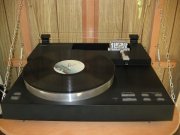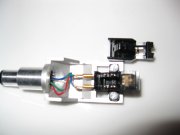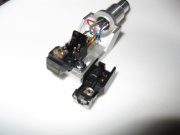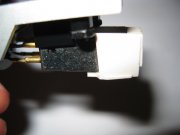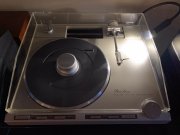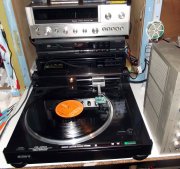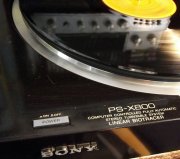I'm still in love with my Pioneer PL-L1000 (sold as the Phase Linear 8000 Series II in the USA). I don't know what I'm gonna do when something goes dead on the tracking system- and I know that eventually it will. It's amazing the prices they fetch when they show up on ebay, sometimes over $1000. As far a consumer turntables go, this was probably the most affordable and reliable LTTT you could get. I bought mine on ebay from a guy in Washington state for $92, listed as malfunctioning, and no one bid against me. The arm lift belt was stretched out of shape (achilles heel of this unit), one of the rails that the arm carriage rode on was loose, and the rear bearing roller was loose as well. Easy to fix mechanically, but things like arm return speed, end-of-record return trip, and stylus point setdown for play all require an oscilloscope to adjust.
I also had one of the Harman/Kardon LTTTs, the ST-8, and that sucker was the most finicky things I've ever screwed with. I liked the mechanical design- which seemed to be more dependable than using optically coupled sensors for tracking correction- but once I had the roller adjusted correctly on the H/K it would work for about a week, and then I would see that the carriage would either lead or lag the cart by a few degrees. The sucker just would not stay in adjustment for very long.
The H/K / Rabco series used a rotating cylinder at the bottom of the tonearm carriage, the cylinder was coupled to the turntable with a belt. A "tire" at the bottom of the tonearm carriage tracked the rotating cylinder and played a game of "catch-up" with the stylus point. All well and good given the pitch of the spiral of the groove on the recorded areas, but for those records that weren't recorded to within 3/4" of the eccentric groove, the mechanism couldn't catch up fast enough, pulling the stylus out of the lead-out, and you ended up hearing the matrix numbers in the deadwax being played through your speakers. Mechanically, it was good in theory, but in practice, way too finicky for the end user to continually adjust.
The platter being coupled to the tracking cylinder (in my experience) also lead to speed inaccuracy. You adjust the speed, see that the strobe markings are stationary, and a few minutes later the speed drifted.
The H/K tonearm was a travesty as well, the "headshell" was in fact the bulk of the tonearm, which prevented the user from quickly swapping out a cart. The screw holes were round so that when you mounted a cart you couldn't adjust overhang to zero with any precision (actually the only cart alignment necessary for LTTTs, other than VTA). This wouldn't be an issue if the cart manufacturers kept the centers of the mounting holes and the stylus tip at the same distance- but- they don't!
Edison's original was probably the best idea: a fixed groove pitch and a screw-driven tonearm!
So these are the only two LTTT designs I've used. Those air-bearing jobs by ClearAudio cost as much as a Harley Fat Boy. Perhaps one day I'll run across a Pioneer PL-L1 at a Goodwill store...

